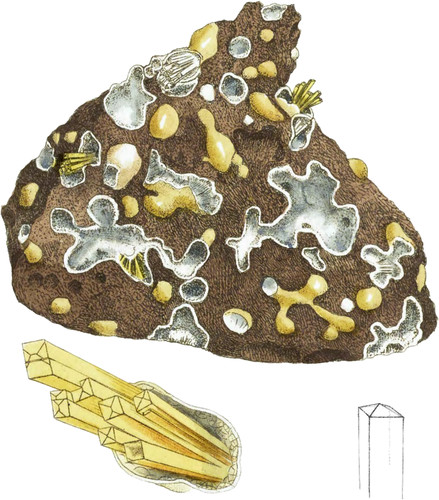 Enlarge
Enlarge
British Mineralogy
Mesotype
- Class 2. Earths.
- Order 1. Homogeneous.
- Gen. Silex.
- Spec.
- Div. Crystallized.
- Syn.
- Zeolithes figurâ determinatâ crystallizatus. Waller. 1. 328.
- Zeolithes Cronst. 108–112.
- Zéolithe en aiguilles prismatiques ou pyramidales. De Lisle, 2. 41.
- Argile unie à la terre silicieuse, faisant la moitié du poids, et quelquefois davantage, et à un peu de chaux. Zéolithe. Sciagr. 1. 301.
- Zeolith. Emmerl. 1. 199. Wern. 1. 265.
- Zeolite. Kirw. 1. 278.
- La Zéolithe. Brochant, 1. 298.
- Mesotype. Haüy, 3. 151.
Perhaps it is one of the most curious phænomena in Nature, that in the craggy Trap Rocks which include so many substances, most of them seem to be passing into new appearances, as if having been of different composition or differently acted upon by confined agents continually working. Thus Quartz, Chalcedony, Hyalite, Anatcime, Chabasie, and the present substance, with some others, sometimes fill a number of spaces, or line them, or are crystallized in various ways. In this instance the crystals are uncommonly interesting, being so like one distinct substance passing out of another, that it has been compared to crystals passing out of shells, the cavity they pass from being often coated with a substance outwardly resembling a pebble fitting the unequal hollow, and itself hollowed by decomposition, and forming these beautiful appearances. Being from Dalton in Lancashire, where it certainly could not have been expected, makes this specimen still more curious; for this substance was thought rare even in Scotland, and has but lately been discovered any where, as will be seen in the next table.
The specimens I possess pass from transparent or opaque white to reddish or topaz-like yellow. They are contained in hollow stone cases, lined as it were by Analcime.—See tab. 59, and the lower left hand magnified figure of this plate. The crystals of Mesotype, which are peculiarly neat right-angled four-sided prisms terminated by obtuse four-sided pyramids, are sometimes a little varied as to the number of their angles: for when any faces of a regular crystal are, as it were, deeper cut, they borrow angles from their neighbours: thus the otherwise regular three-angled plane of the four sided pyramid, trespassing occasionally on the column and opposite faces, becomes six-sided; which will be easily understood by the figure.
This substance differs from Stilbite and other substances which have been called Zeolites, not only in the form of the crystal, but in the fracture, and in being electric by heat. It is so far soluble in nitric acid as to form a jelly, which other similar minerals are not. Zeolites in general may be known by their being capable of a particular kind of ebullition, forming a frothy enamel under the action of the blowpipe.
I figure some from Raghlin in Scotland, and have some specimens nearly similar, but not so fine, from Antrim, found among Basalt, and some from the county of Derry, by favour of my kind friends Dr. Scott, John Templeton, Esq., and Mr. Tennant.
I suppose, now it is made known, it will be recognised in many places in Great Britain. It is, however, still to be remarked, that our authors are more generally backward to acknowledge British specimens than foreign ones.

